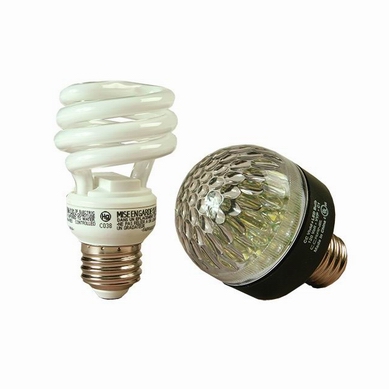
CFL vs. LED
Both compact fluorescent lamps and light-emitting diodes offer better energy efficiency that standard incandescent bulbs, but LEDs cost a lot more. Are they worth it?Standard incandescent light bulbs are among the most profligate energy consumers available, turning more than 90% of the energy they consume into heat rather than light. These old-school bulbs are inexpensive and cast a pleasingly warm light, but their days are numbered.
Compact fluorescent lamps (CFLs) are gradually taking their place. Although they’re more expensive, the cost is coming down and dimmable versions have become available. Bulb life is much longer and, more important, CFLs deliver much more light per watt of electricity than incandescent bulbs.
More recently, light-emitting diodes (LEDs) have emerged as another option. The cost is still well above that for CFLs, but LEDs last a very long time.
Are they worth the extra expense? That’s the question posted by George Lee in a recent Q&A post at GreenBuildingAdvisor, and the topic of this week’s Q&A Spotlight.
“I am renovating a 100-year-old home entirely,” Lee writes, “and I’m buying electric supplies right now. Are LED recessed lights worth it? Or should I buy standard recessed light fixtures and buy LED bulbs later?”
Lee is working on a shoestring budget. The house was in such poor repair he was forced to gut it and make extensive repairs. It has no heat, and the banks won’t loan him a dime. Keeping costs down is a high priority.
So don’t waste your money on LEDs
Forget the LEDs, advises GBA senior editor Martin Holladay. “Right now, the best LED lamps have approximately the same efficiency as the best CFLs, but they cost about 10 times as much,” Holladay says. “Although LED lamps should last longer than CFLs, you won’t see any savings from switching to LEDs — unless the labor cost…
Weekly Newsletter
Get building science and energy efficiency advice, plus special offers, in your inbox.

This article is only available to GBA Prime Members
Sign up for a free trial and get instant access to this article as well as GBA’s complete library of premium articles and construction details.
Start Free TrialAlready a member? Log in





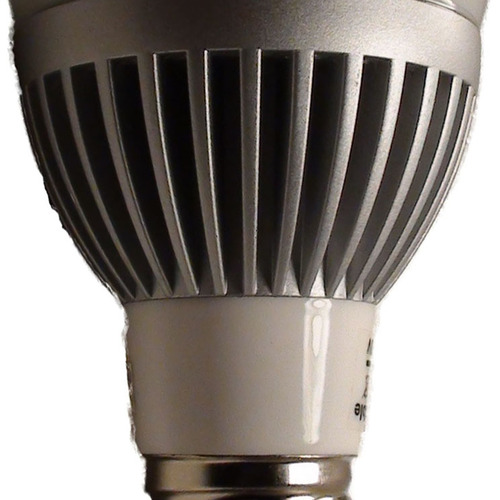
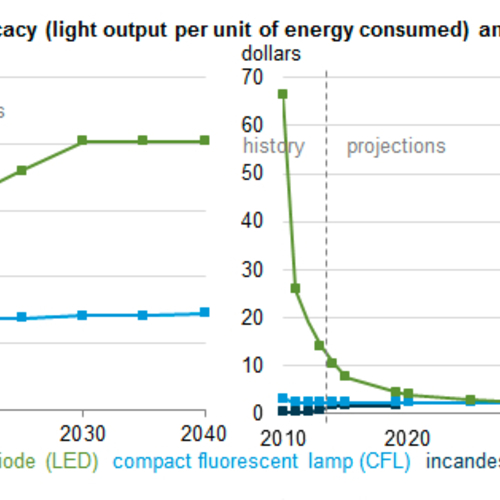
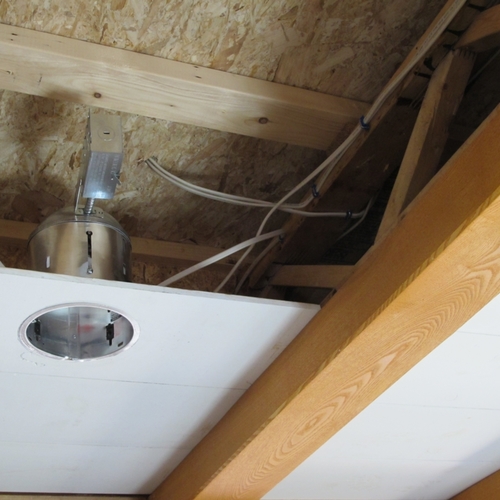
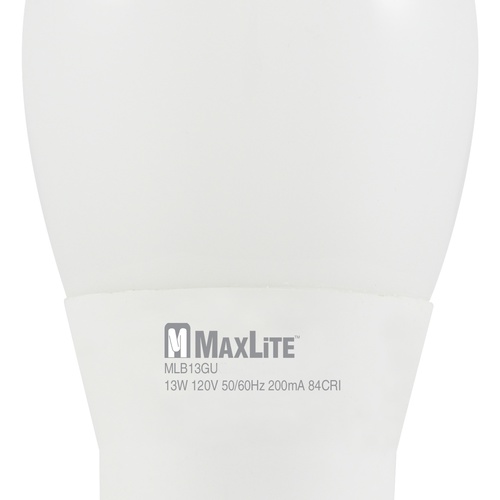






10 Comments
Options abound
The biggest takeaway here is that there are numerous options to consider when switching out incandescent lighting. It's extremely important to consider the lighting purpose and room specs to help figure out which option will be best. Both LEDs and CFLs have their pros and cons, especially between different manufacturers and models. Compare these with regards to the space you are retrofitting to come up with the best game plan.
LEDs versus halogens in bathrooms
I bought a house with two 60 watt halogen light fixtures in our windowless master bathroom> Here is the simple payback analysis of replacing them with 8 watt (40 watt equivalent) PAR-20 LEDs:.
Simple Payback: Replacing two 60 watt halogens w. two 8 watt, PAR20 LEDs
Type Brand Outlet Watts Life (Hrs) Cost
Halogen GE Edison Flood Lowe's 60 2,000 $8.18
LED LSG EcoSmart Home Depot 8 50,000 $24.97
Hrs Hrs/Yr Energy Cost Savings/Yr Payback (Yrs)
Halogen LED
3 1095 $15.51 $2.07 $13.44 2.50
4 1460 $20.67 $2.76 $17.92 1.87
8 2920 $41.35 $5.51 $35.83 0.94
12 4380 $62.02 $8.27 $53.75 0.62
24 8760 $124.04 $16.54 $107.50 0.31
Example calculations @ 3 hrs (3 * 365 = 1095 hrs / yr):
Halogen: 1095 * 120 watts / 1,000 = 131.4 kWh / y * $0 .118/kWh = $15.51
LED: 1095 * 16 watts / 1,000 = 17.5 kWh / yr * $0.118/kWh = $2.07
"Bulb" cost difference (2 "bulbs"): $49.94 - $16.36 = $33.58 /13.44 = 2.5 Years
In the example above the 8 watt, 40 watt equivalent, PAR-20 LEDs produced slightly more and higher quality light than the 60 watt halogens while generating a simple payback of 2.5 years at only 3 hours of use per day.
There are some settings where LEDs make economic sense right now.
Response to William Rau
Rau,
Of course it makes sense to get rid of your power-hungry halogens. But comparing LEDs to halogens is misleading. The other option under consideration in this discussion is CFLs, not halogens. No one has suggested that halogens make sense.
There are some deals on LEDs
“Right now, the best LED lamps have approximately the same efficiency as the best CFLs, but they cost about 10 times as much,”
My local Home Depot has a 40W equivalent LED A19 for $17 now. That's probably only 4X as much as the equivalent CFL. So the field is changing quickly.
Another good source for the latest in cheap LED lighting is Sam's Club. Don't expect to be able to buy the same offerings for more than just a few months though. Once they sell out of a style, you may not ever see it again.
And if you find that the cheap ones are too dim, here's a solution:
http://greenbuildingindenver.blogspot.com/2009/12/led-lighting-in-2009.html
Response to Martin:
CFLs would not fit in my light fixtures, and if they had, the quality of light would have been poor. In addition, CFLs often do not work well or have shortened life expectancy in can or downward facing light fixtures.
I rely mostly on CFLs in my home, but a large number of people dislike them for a variety of reasons (mercury, poor light quality, flicker, etc.). In contrast, LEDs are superior to both CFLs and incandescents in light quality.
Prices on LEDs should drop 15% to 20% per year over the next several years. At a price point of $18, a 120 lumen/watt LED will use 88% less electricity than an incandescent and will have a payback of less than 3 years. By 2013 a mass exodus to LEDs from incandescent stalwarts will begin because if will make economic sense to replace these 19th century relics.
60 watt eq. LED in 2012 for $15
Lighting Science Group will release a 60 watt equivalent LED in 2012. it will consume 8.5 watts of electricity. See:
http://www.greentechmedia.com/articles/read/lighting-sciences-15-led-bulb-four-reasons-why-leds-are-the-new-pcs/
I can attest to the quality of LSG LEDs, which are carried by Home Depot. They produce excellent light.
Missed the advantage of nimble "task" lighting?
I think the article missed one potentially important advantage for LED's that transcends their present lower efficacy relative to fluorescents: form
Most fluorescents on the market that I've seen tend to have fairly large form factors for their fixtures, while LED's generally appear more versatile in their applications (from tiny little key ring light to high-end LED sheet panels). Due to their versatility, you can place LED's in remote, recessed, or otherwise hard to light areas. We've seen the adverts on TV-- don't let their pitchman tones and schlocky histrionics dissuade you from pragmatic purpose. I've placed mine in closets, corridors for motion-activated corridor lighting, in recessed corners of cabinets (like at the deep corner of an L-shaped kitchen cabinet). I have a great time obviating the bulk lumens (and wattage) of overhead lights with the grace of just enough LED light just where I need it. By efficacy standards, my cheapo LED's might not be as good, but in overall energy consumption, as well as practicality and cost, they're a clear winner. Their color rendition isn't great either, but it's a lot better than the narrow caves of darkness I had before. To take my descriptions to logical extremes-- what kind of lighting do you think gastroenterologists use for their endoscopies? You better hope it's not a T8! (pardon my puerile guffaws)
And yes, currently this is the realm of do-it-yourselfers and smart consumers, and not anywhere in the ballpark of the design professionals I personally work with. I believe that it somehow strikes many of them as somewhat inelegant. But then, I'm just an unfrozen caveman engineer, and it seems that non-monetary values seem are correlated with the price tags affiliated with their fulfillment.
In the LED lighting world, I'm hoping we're on the cusp of a proliferation of possibility.
Halogen/led comparison
Reply to William Rau
The comparison is not apples to apples.
You should compare a 12 watt led to get the equivalent light to your 60 watt halogen.
How many hours per day?
William Rau highlights one of the key questions in this analysis: How many hours is the light in use? Cree's website calculator defaults to 18 hours/day, resulting in the 18 month payback. But many fixtures in my home are on far far less - say 15 minutes or less in a closet or basement. Cree calculates the payback then at 80+ years!
Incandescents remain my lamp of choice for applications where use is intermittent: entries, closets, basement stairs, guest rooms... CFL where use is continuous for a couple hours at a stretch, and LED if use is near-continuous, and/or instant-on is needed.
Invest a Little Bit in LED's
We changed over mainly to CFL's a number of years ago - and I would never go back to incandescent.
The exception is the few lights we want dimmable (theater room, living room over-head). We have been slowly changing these over to LED - testing to see if we like it, and metering out the cost.. At the current prices, will they ever pay off? Not really. However, as the technology matures and the markets expand, they will become viable, just like CFL. So I'm willing to buy a few now at higher prices to help fund the businesses to continue with R&D, knowing the future will be better.
Log in or become a member to post a comment.
Sign up Log in